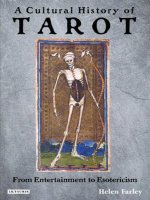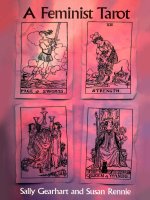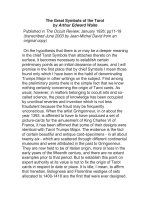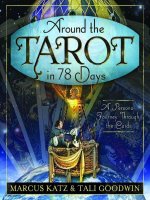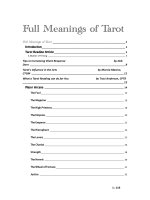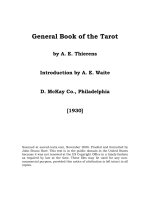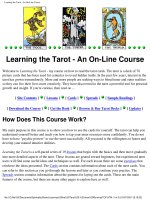Hướng dẫn bói bài Tarot A french method of fortune telling by cards
Bạn đang xem bản rút gọn của tài liệu. Xem và tải ngay bản đầy đủ của tài liệu tại đây (50.36 KB, 10 trang )
A.E. Waite, “A French Method of Fortune Telling”
Manual of Cartomancy and Occult Divination, Rider, 1912
A
FRENCH METHOD
OF
FORTUNE-TELLING
BY
CARDS
By
A.E. Waite
Edited, Spell Checked and Paragraphed
by
Meghan Roberts
2001
Additional Layout
by
Greg Wotton
Page 1 of 10
A.E. Waite, “A French Method of Fortune Telling”
Manual of Cartomancy and Occult Divination, Rider, 1912
THE methods of divination by cards are sufficiently numerous in France, as they are in other
countries, including England. Our own, however, are chiefly of continental origin, while, so far as
it is possible to speak with any positive opinion upon so dubious and involved a question, it would
appear that the French systems are largely particular to themselves, subject of course to the fact
that proceeding in all cases on certain general principles, to that extent they may be said to derive
from one another, or at least from a common root. I have selected for inclusion one system which
-- although it first came into notice at the beginning of the nineteenth century -- is likely to be new
to my readers. It is worked with a piquet set of ordinary playing cards, which, as most people will
know, consists of the usual picture-pieces and the ace, 10, 9, 8 and 7 of each suit, excluding the
lower numbers. The method has appeared, I believe, under more than one auspice, but the
imputed author termed himself an Egyptian and claimed to publish his little treatise at Memphis,
which, however, stands for Paris. It is not a very full method and is not free from confusions as it
was first issued. In the form which here follows it has been so far rectified and extended from
other French sources that it will, I think, serve the purpose as an alternative to the English system
given in the previous section. I must explain, however, that those who intend to make use of it
should obtain, if possible, a set of French or Swiss cards, in which the picture-pieces appear at full
length, instead of with a head at either end, and all the numbers are marked Droit and Renverse at
their opposing poles, meaning right side up and reversed Otherwise, an English set may be so
marked by the student. Important differences attach to the variations in question, so far as the
trump-cards are concerned, as they do indeed in the English method.
It may not be impertinent to mention before proceeding that the origin of card-playing has been
referred by some French writers to one Jacquemin from whom two sets were purchased in 1392
to amuse Charles VI, King of France, during his days of distraction. It is at most obvious that the
simple historical fact can be only an episode in the French history of cards; the evidence is
concerning sale and purchase, and it would be fantasy to assume that the vendor in the specific
instance was also the inventing artist. Spain and Italy are sometimes said to have been in
possession of cards prior to the French people; it has been even speculated that they were brought
to Italy by Greek emigrants from Constantinople, that they drifted from Italy into Spain and
thence to our Gallic neighbors. It is certain, in any case, that they were in Italy at the very time
when their existence is first on record in France, for they are mentioned in a Florentine chronicle
written towards the close of the fourteenth century, while so early as 1332 it is said that they were
prohibited in Spain by an edict of Alphonsus XI. If the latter statement rests on authority, it leaves
the reason doubtful, and I mention this point to add that we have little opportunity of deciding
when cards were first used as a game of hazard; it has been thought that at their inception they
were designed for instruction or amusement, and contained no combinations of members, so
essential for gambling arts. The earliest records which I have cited offer no indication of the cards
that composed the sets, either as to design or quantity; therefore the symbols and numbers may or
may not have corresponded when first we hear concerning them to the Tarot packs, which -either independently or otherwise -- were certainly in existence about the same period. It is
indubitable, as I have stated already, that these were the precursors of our playing cards, but there
are wide differences in most of the archaic sets. It can only be said that the scheme of symbolism
which is comprised in the major trumps is unquestionably old, as it is indubitably of great
importance, though nearly all that has been written heretofore upon the subject is referable to the
Page 2 of 10
A.E. Waite, “A French Method of Fortune Telling”
Manual of Cartomancy and Occult Divination, Rider, 1912
realms of reverie. A separate section is devoted, however, to the Tarot elements, the higher
construction of their meaning and its application in an exalted sense. It remains only to say that
French cartomancy in the eighteenth and nine-teenth centuries set the fashion to the whole
English-speaking world, if not to Europe itself- that Alliette, or Etteilla, Mlle. Lenormand,
Madame Clement and Julia Orsini were the prophets of all divination with all varieties of cardsand that, except in certain secret circles, where there is supposed to be a special tradition, we have
done little more than follow them.
I will give, in the first place, the general signification of piquet cards according to various
authorities, and these may be compared with the alternative renderings which have been
enumerated already in connexion with the shorter English method. It will be understood, as in
other cases, that everything depends upon the insight, intuition, divining gift, or -- as it is called
somewhat conventionally -- the clairvoyant faculty of the operator.
Page 3 of 10
A.E. Waite, “A French Method of Fortune Telling”
Manual of Cartomancy and Occult Divination, Rider, 1912
1 4YQ]_^Tc
The Ace. -Letters, or news at hand otherwise.
King. -Friendship; if followed by the Queen, marriage; if reversed, impediments, difficulties and
the vexations thereto belonging.
Queen. -A woman from the country, who is fair but evil-speaking; reversed, more directly inimical
to the Querent in word and also in deed.
Knave. -A postman, valet, postillion, soldier, or messenger bearing news. The news are good if
the card is right side up and bad if it appears reversed.
Ten. -Great joy, change of place, a party from the country.
Nine. -Delay and postponement, but not resulting in failure.
Eight. -A man of business or young merchant, who is commercially related to the Querent.
Seven. -Good news, above all if accompanied by the Ace.
2 8UQbdc
The Ace. -Joy, contentment, and -- if it is accompanied by several picture-cards -- marriages,
feasts, etc;, in pleasant company.
King. -A rich man, banker, or financier, well disposed, and may promote the interests of the
Querent. If reversed, the person is miserly and to deal with him will prove difficult.
Queen. -An honest, frank and obliging woman; if reversed, there will be some obstacle to a
projected marriage.
Knave. -A soldier or young man, who is anxious to promote the Querent's welfare, will play some
part in his life and will be allied with him after one or another manner.
Ten. -A surprise, but often one of a kind which will be advantageous as well as agreeable to the
consulting party.
Nine. -Concord.
Eight. -Domestic and private happiness, attended by success in undertakings; exceedingly
felicitous for the destinies of the middle path, the amenities of the quiet life.
Seven. -Marriage, if the Querent is a lady, and the issue will be daughters only; if a man, it is
destined that he will make a rich and happy marriage.
Page 4 of 10
A.E. Waite, “A French Method of Fortune Telling”
Manual of Cartomancy and Occult Divination, Rider, 1912
3 C`QTUc
The Ace. -In company with the ten and nine, this card signifies death, grief, more especially from
bereavement, but also sorrow from many sources; it includes further the idea of treason and
possibly of loss by theft or robbery.
King. -A magistrate or lawyer, whose intervention may prove disagreeable; the card reversed
signifies loss in a lawsuit or general derangement of affairs.
Queen. -A disappointed woman -- possibly a widow in dejection; if reversed, one who is anxious
to remarry, unknown to or in spite of her family.
Knave. -Some kind of disgrace which will be inimical to the peace of mind and perhaps even the
liberty of the Querent; reversed, serious complications for the person concerned; also betrayal in
love, if the Querent is a woman.
Ten. -Imprisonment for a man, if followed by the Ace and King of the same suit; for a woman,
disease, illness.
Nine. -Protraction and difficulties in business; followed by the Nine of Diamonds and the Ace of
Clubs, delay in the receipt of expected money
Eight.-Arrival of a person who will carry bad news if followed by the Seven of Diamonds and
near to a picture card- whether King, Queen or Knave- tears, discord, destitution or loss of
employment.
Seven. -Quarrels, inquietude; if ameliorated by the vicinity of some Hearts, it promises safety,
independence and moral consolation.
4 3\eRc
Ace. -Advantages, commercial and industrial benefits of every kind, easy collection of dues,
unmixed prosperity- but these more especially when followed by the Seven of Diamonds and the
Seven of Clubs.
King. -An influential, powerful person, who is equitable and benevolent towards the Querent, to
whom he will render signal services; but reversed, this personage will experience some difficulty
in his proceedings and may be even in danger of failure.
Queen. -A dark woman, rivalry, competitive spirit; in the neighborhood of a card which stands for
a man, she will have preference for the man in question; on the contrary, in proximity to a
feminine card, she will be in sympathy with the Querent; reversed, she is very covetous, jealous
and disposed to infidelity.
Page 5 of 10
A.E. Waite, “A French Method of Fortune Telling”
Manual of Cartomancy and Occult Divination, Rider, 1912
Knave. -One who is in love, a proper young man, who pays court to a young lady; placed next to
a feminine card, his chances of success are very good; side by side with a man, there is reason to
hope that the latter will come actively to his assistance and will contribute to his success, unless
the said man should be signified by the Knave of Hearts, which presages a dangerous rivalry;
reversed, there is reason to fear opposition to marriage on the part of the person's parents.
Ten. -Prosperity and good fortune of every kind; at the same time, if followed by the Nine of
Diamonds a delay is foreshadowed in the return of money; contrary to all, if this card is side by
side with the Nine of Spades -- which everywhere signifies disappointment complete failure is
promised; so also if the question at stake is a lawsuit, loss is probable.
Nine. -Success in love; for a bachelor or spinster, approaching marriage; for a widow, her second
nuptials.
Eight. -A favorable conclusion which may be anticipated by the Querent in financial and business
matters.
Seven. -Anxieties occasioned by love -- intrigues; followed by the Seven of Diamonds and the
Nine of Spades, abundance of good things and rich family inheritances.
Page 6 of 10
A.E. Waite, “A French Method of Fortune Telling”
Manual of Cartomancy and Occult Divination, Rider, 1912
Mode Of Operation In Specified Cases
I
6_b =QbbYQWU Q^T CY]Y\Qb CeRZUSdc
Shuffle the cards of a piquet set and cut three times. If an actual marriage is in question, remove
two cards, representing the lover and the lady whose fortunes are at issue. Place these cards, face
upwards, on the table before you. As usual, fair people are represented by Hearts and Diamonds
but those of dark complexion by Clubs and Spades. The attribution, between these lines, seems to
be usually at predilection or discretion, but Diamonds are sometimes taken to signify very fair
people and blondes, while Spades are for actual brunettes and very dusky complexions.
Lay out the rest of the cards three by three; in every triplicity which produces two of the same
suit, select the higher card of that suit and place it by the side of the other card
which stands for the Querent. Throw out the rest for the moment, but they will be required later.
When any triplicity produces entirely different suits, put aside all three in the rejected pile. When
the entire cards of the set have thus been dealt with in succession, take up the rejected lot, and
after shuffling and cutting as before, proceed in the same manner until you have drawn fifteen
cards and placed them by the side of the Querent.
If the Querent is a dark man, he will not have his wish regarding the marriage contemplated unless
a tierce to the King in Clubs be among the fifteen cards. It may of course happen that the King has
been drawn to represent him. If, however; he be a Spade, then alternatively there must be a tierce
in Spades.
The same rule obtains if the Querent is a dark young lady, but in addition to a tierce in the suit
there must be the Ace of the suit also.
If the Querent is a fair man or woman, then a tierce in the one case and a tierce and the Ace in the
other must be found in Hearts or Diamonds according to the grade of their fairness.
If the question concerns a marriage to take place in the country, it has been held by the expositors
of the system that a tierce to the King in Diamonds is indispensable. This seems to involve the
system in respect of fair people, but it is only a confusion of expression. If Diamonds correspond
to the Querent, that tierce must obviously be present, or ex hypothesi there will be no marriage;
but if present the inference is that the Querent will get his wish in respect of locality as well as of
the fact of marriage. On the other hand, if the Querent is referable to any other of the three
remaining suits, then ex hypothesi to attain his presumed wish for a country wedding, he must
have the tierce in Diamonds as well as in his own suit. It is not very probable that the alternative
between town and country will arise as a subsidiary question, and if it does, it might be better to
determine it separately by the help of some other system. It serves no purpose to ignore the
Page 7 of 10
A.E. Waite, “A French Method of Fortune Telling”
Manual of Cartomancy and Occult Divination, Rider, 1912
shades of complexion in fair people and represent them indifferently by Diamonds, as this would
be forcing the oracles and would make the reading void.
Finally, if the marriage question concerns a widower or widow, it is equally essential that the
cards drawn should furnish a tierce to the King in Spades and the Ace of Hearts- which again is
very hard upon all persons who are not represented by Spades. The inference is that second
marriages are rare.
II
6_b AeUcdY_^c _^ 9^XUbYdQ^SU
Shuffle and cut as before, and place on the table a card which is held to typify the Querent. The
presence of the Ace of Spades, manifesting right side up, indicates profit in consequence of a
death that is to say, an inheritance or legacy. If the Ace is accompanied by the Seven, Eight, Nine
and Ten of Clubs, there will be a large increment of money. The combination may be difficult to
secure, but very large inheritances are rarer than second marriages.
III
6_b
No judgment can be given on the chances of a lawsuit, actual or pending, nor generally on things
of this nature, unless the King of Spades comes out in the dealing. If that card is held usually to
represent the Querent, then it only follows automatically that a judgment is possible, and it is so
much the easier for him in such case. The shuffling, cutting and dealing proceed as before, and if
the Ace in question serves to complete the quint major in Spades -- that is, the Ace, King, Queen,
Knave and Ten -- it is to be feared that the suit will prove good for nothing, either by going
against the Querent or bringing him no profit in the opposite case. But if the Ace is accompanied
by the four Tens, the chances are excellent. They are said also to be more than good in another
event of the dealing which I forbear from dwelling on, as it is practically, if not otherwise,
impossible for the fifteen cards -- which the dealing proposes to extract -- to be all of the red
suits. It is well known that compilers of works on cartomancy sometimes forget the limits
prescribed by their systems and get consequently into ridiculous plights.
IV
6_b Q DXUVd
For the discovery of a thief, the presence of the four Knaves is indispensable to any reading, and,
as it happens, it is not utterly difficult -- though it is none too easy -- that the chances of the cards
should produce them. The procedure is throughout as before. If the King and the Eight of Spades
turn up among the fifteen cards, this means that the thief is already in prison; if the Ace of Spades
is among them, the prisoner will be in danger of death; the presence of the Ace of Clubs, the King
of Clubs and the Queen of Hearts will afford some hope that the person who stole will himself
make restitution; lastly, the predominance of Diamonds offers ground for believing that the thief
has been arrested, but on another charge than that which would be preferred by the Querent on
his own part.
Page 8 of 10
A.E. Waite, “A French Method of Fortune Telling”
Manual of Cartomancy and Occult Divination, Rider, 1912
V
6_b Q @Ubc_^ Y^ @bYc_^
The question at issue is whether the captive has any chance of speedy liberation. The procedure is
throughout as before, except that the card selected is held to represent the person in durance
instead of the Querent. The fifteen cards having been produced as the result of the working, they
should be examined in the usual way. The presence of the Queen of Hearts, Knave of Clubs, Nine
of Clubs and the four Aces will give ground for hope that liberation will be easy and at hand. In
proportion as these cards are absent, there will be delay in the desired event, and if none are
found, it is likely to be rather remote. On the other hand, the appearance of the Eight and Nine of
Spades, the King of Spades, and the Knave and Nine of Diamonds, will signify that liberty shall be
scarcely obtained, except after many obstacles and much consequent postponement.
VI
6_b DbQfU\Ubc
It is assumed that the Querent is not himself on a journey but is consulting the oracles for one in
whose fortunes he is for some reason interested, by ties of friendship or otherwise. Proceed as
before, selecting a card to represent the absent person. When the dealing is finished, the resulting
cards should be consulted to ascertain whether they include the Ace of Hearts, the Ace of
Diamonds and the Ten of Diamonds, the presence of which will foreshadow probable news.
Probability will be raised into certainty by the appearance of the Seven of Diamonds. If, however,
the Ten of Spades is found in proximity to the card representing the person who is away on his
travels, there will be reason to fear that he is ill; so also the Ace of Spades reversed will mean that
he is in other danger than sickness. If he is to succeed in the enterprise that has called him abroad,
he will be escorted by the Nine of Hearts, the Ace and the King of Clubs. Finally, if the Eight of
Diamonds is found in relation to his own card, this means that he is on the point of returning.
There is a variation of procedure in all the above cases, which consists in protracting the dealing
till twenty-one cards have been drawn instead of fifteen. It is put on record by the so-called
Egyptian, speaking from the seat of knowledge, that the predominance of red cards as the result
of operation in any given instance foretells great success for the person on whose behalf the
consultation is made. The Ace, Ten, Nine, Eight and Seven of Hearts are premonitory of news on
which the Querent may be congratulated. The same cards in the suit of Clubs promise success in a
lawsuit, or a lucky number in a lottery. The same in the suit of Spades prognosticate news of a
relative's death, or that of a friend, but whether there will be profit to the Querent is not so
certain, having regard to the generally fatal nature of this suit, the constituents of which may be
said almost to constitute the greater misfortunes in cartomancy. The particular numbers in the suit
of Diamonds carry with them the same kind of prevision as Hearts.
So far the Egyptian and those who have followed in his footsteps and have extended his method.
There are probably several other systems of fortune-telling by means of piquet cards; but as there
is no particular authority, so also, and certainly, there is no advantage in thus reducing the
elements on which divinatory calculations can be made. The cards below seven in an ordinary
pack have their special meanings and therefore their special use. It is obvious that a fuller reading
Page 9 of 10
A.E. Waite, “A French Method of Fortune Telling”
Manual of Cartomancy and Occult Divination, Rider, 1912
can be obtained with a fuller set, and this is one reason -- apart from their incalculably superior
symbolism -- why Tarot cards, with so many additional numbers, are richer than ordinary cards
for the purposes of cartomancy. It should be understood, therefore, that in presenting the French
method I am not concerned with recommending it, except in respect of simplicity, to those who
are interested in such matters, and although, outside the modes of dealing, I have included from
another source only the separate short signification of the two-and-thirty cards, there is no reason
why the student or reader should not take advantage of the full pack. Both within and without the
present collection, there are ample opportunities to ascertain the significance of the smaller cards;
their presence will not stultify the system for those who care to follow it; and, as I have indicated,
they help the reading. When the eye of the intuitive mind is open, it is well in things of this kind
that the materials on which it can work should not be unreasonably restricted. The thirty-two
piquet cards are not the two-and-thirty paths of the absolute according to Kabalism, and so there
is no special magic in the lesser number, or if it resides anywhere deeply perdu it has not been
given me to find it, a deficiency which I share apparently with those who invented the system, for
they have certainly failed to adduce it.
----Corrected and formatted by hand.
Page 10 of 10
